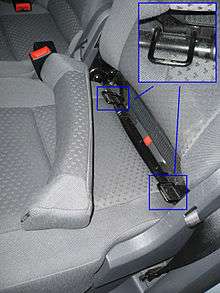Isofix

ISOFIX is the international standard for attachment points for child safety seats in passenger cars. The system has other regional names including LATCH ("Lower Anchors and Tethers for Children") in the United States and UAS ("Universal Anchorage System") or Canfix in Canada.[1] It has also been called the "Universal Child Safety Seat System" or UCSSS.
ISOFIX is International Organisation for Standardisation standard ISO 13216, which specifies the anchoring system for Group 1 child safety seats. It defines standard attachment points to be manufactured into cars, enabling compliant child safety seats to be quickly and safely secured. ISOFIX is an alternative to securing the seat with seat belts. Seats are secured with a single attachment at the top (top tether) and two attachments at the base of each side of the seat. The full set of anchor points for this system were required in new cars in the United States starting in September 2002.
In the EU the system is known as ISOFIX and covers both Group 0/0+ and Group 1 child safety seats. The mechanism for attaching the seat to the Lower Anchors is quite different from that in the United States. In the EU two "alligator-like" clips connect the seat to the Lower Anchors rather than the open clip style connectors commonly used in the United States.[2] However, some carseat manufactures are beginning to offer true ISOFIX type attachments in the U.S. In the European standard, there are also various installation categories: "universal", "vehicle-specific" and "semi-universal". The main difference is that "Universal" represents use of a top tether strap with the ISOFIX anchorage, "vehicle-specific" represents the usage of the ISOFIX anchorage without the TopTether in specified vehicles only, while "Semi-Universal" represents usage of the ISOFIX anchorage together with a "foot-prop".[3][4]
Isofix is designed to secure a maximum combined weight (Weight of both seat and child) of 33kg.
The center-to-center distance between the anchors of ISOFIX (and also LATCH) systems is 280 mm.
For Group 2/3 seats there is a system called ISOFIT which anchors the seat to the vehicle so it cannot slide around when not in use. In the case of Isofit, the child is held into the seat using the vehicle's existing seat belt system, not the safety seat's straps.
On September 19, 2014, the Australian government legalized the use of ISOFIX child seats. Prior to this date, their sale (and use) in Australia was illegal.[5]
History
The ISOFIX system was developed jointly by child safety seat maker Britax-Roemer and automobile maker VW, with the first compatible products released in 1997.[6]
ISO 13216 part 1 (covering lower anchorage points) was published in 1999. Part 2, covering top tether anchorages was published in December 2004.[7][8]
Amendments to include ISOFIX in UN ECE Regulations 14 & 44, which specify uniform provisions for the design of vehicle seat anchorages and child safety seats, came into force in February 2004.[9][10]
Under the current UN/ECE R14, all new vehicles produced since February 2013 are required to have ISOFIX lower anchorages and top tether attachments.
References
- ↑ "Information on LATCH (Lower Anchors and Tethers for CHildren)". Car-Safety.Org. February 29, 2008. Retrieved 2008-07-06.
- ↑ "Information on ISOFIX/LATCH". Car Safety for Kids Blog. May 8, 2008. Retrieved 2009-08-03.
- ↑ "DUO plus Typenliste" (PDF). Retrieved June 26, 2008.
- ↑ "SAFEFIX plus Typenliste" (PDF). Retrieved June 26, 2008.
- ↑ "ISOFIX child seats legalised for Australia".
- ↑ "Britax history and heritage". Retrieved April 1, 2014.
- ↑ "ISO 13216-1:1999". Retrieved April 1, 2014.
- ↑ "ISO 13216-2:2004". Retrieved April 1, 2014.
- ↑ "United Nations ECE Working Party on Passive Safety - Proposal for draft supplement 5 to the 03 series of amendments to Regulation No 44" (PDF). Retrieved April 1, 2014.
- ↑ "UN ECE Regulation No 44" (PDF). Retrieved April 1, 2014.